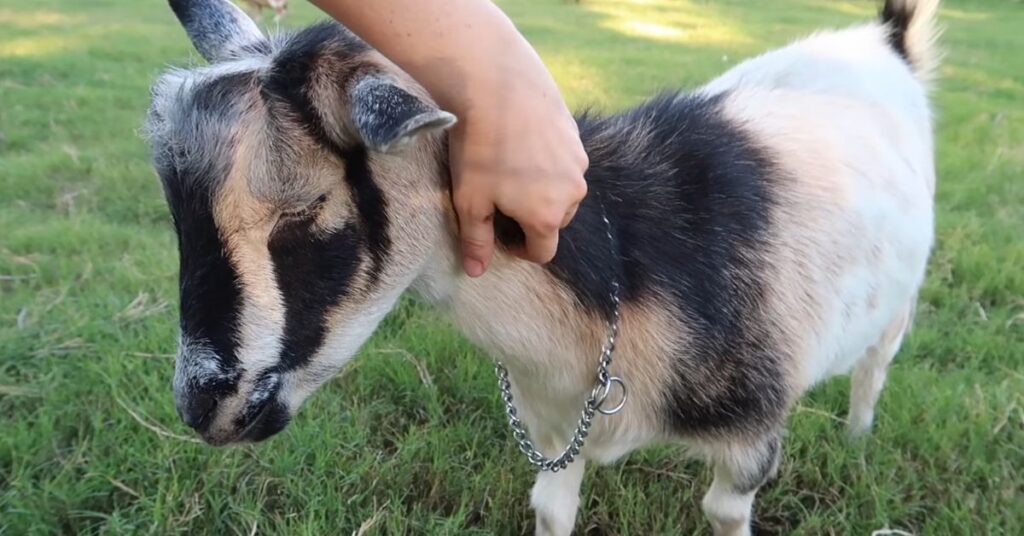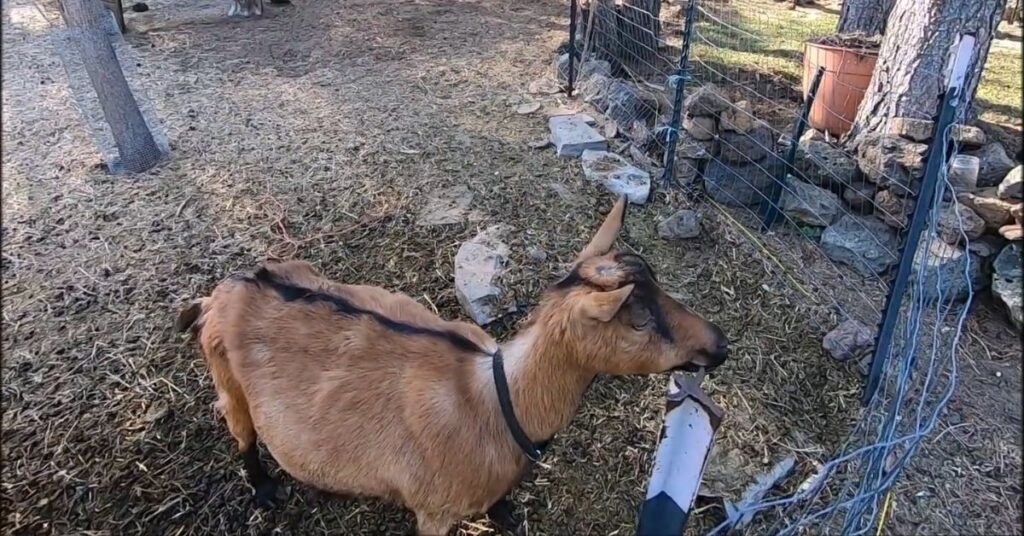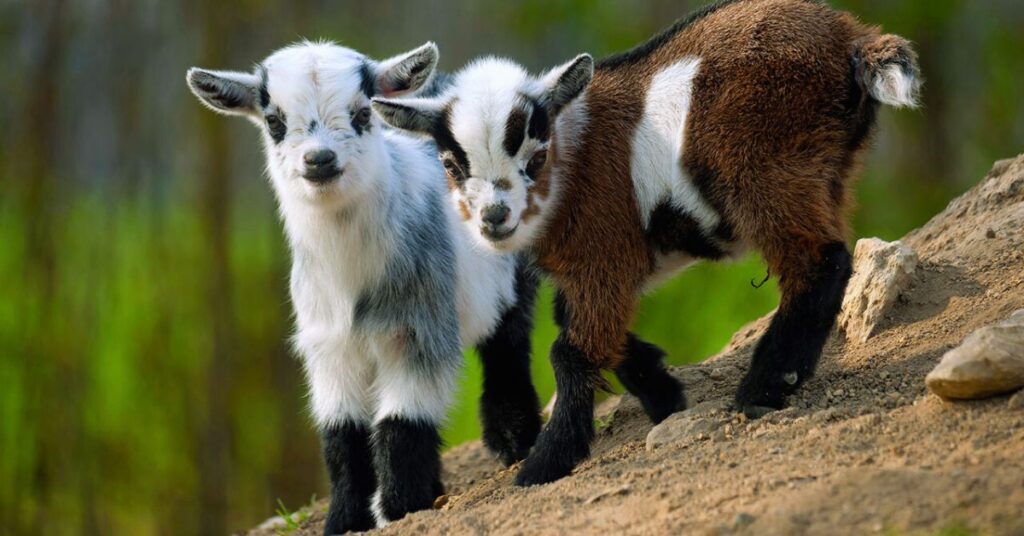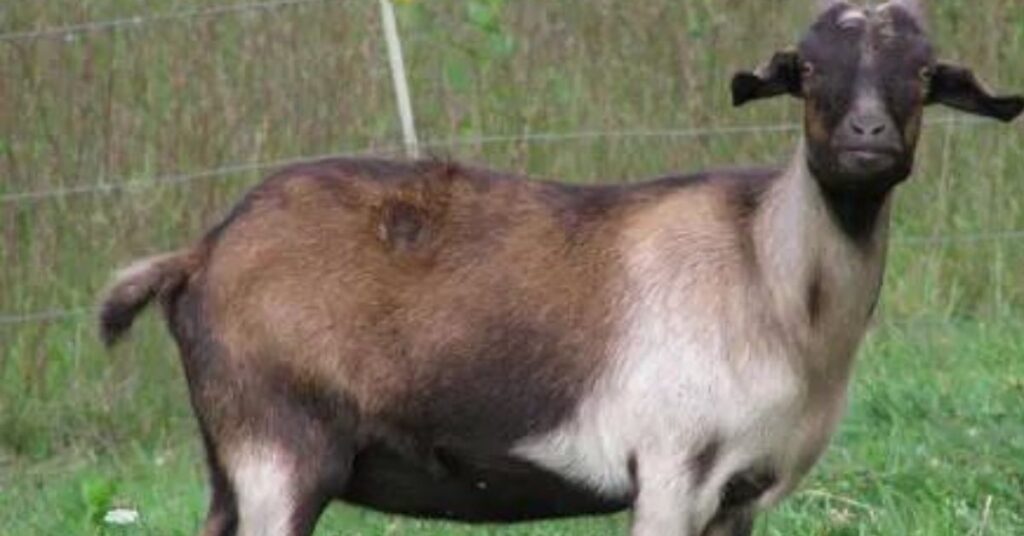Goats are a popular livestock choice for many homesteaders and small farmers. They provide nutritious milk, meat, and fiber while grazing on plants and vegetation that other livestock won’t eat. Goats are also much easier to handle and require less space than cows or horses.
However, most goats grow horns that begin to sprout in early infancy. While horns serve a purpose for goats in the wild, domestically raised goats are usually dehorned for safety reasons. Horned goats are prone to getting their horns stuck in fencing and farm equipment. They can also be more aggressive and injure humans or other goats.
Luckily, certain breeds of goats lack horns from birth due to their genetics. These naturally polled or hornless goat breeds make ideal choices for small farms, 4-H projects, and pets. Let’s explore some of the most popular hornless goat breeds and what makes them so special.
Nigerian Dwarf
The Nigerian Dwarf is a miniature dairy goat originally from West Africa. The breed was imported to the United States in the early 1900s.
- Size: Does stand 17-19 inches tall at the withers and weigh about 50-80 lbs. Bucks are slightly larger at 19-21 inches and up to 100 lbs.
- Appearance: Nigerian Dwarfs can be any color or pattern. Black, chamois, and chocolate brown are common. They have a refined dairy appearance with a level topline and alert ears.
- Horns: Most Nigerian Dwarfs are naturally polled. Only about 5% of the breed has horns.
- Milk Production: Does produce an average of 1-2 quarts of milk per day. The milk is very high in butterfat, around 6-10%.
- Temperament: This breed is known for its friendly, energetic, and intelligent temperament. Nigerian Dwarfs make great pets and 4-H projects.
The small size, colorful appearance, and gentle personality of the Nigerian Dwarf make them a favorite among children. Their high-butterfat milk is perfect for cheese and soap making. Nigerian Dwarfs are also easy to handle due to their naturally hornless trait.

LaMancha
The LaMancha is an American breed developed in the early 20th century by crossbreeding Swiss and Spanish breeds like the Nubian and Murciana. They are best known for their very short ears.
- Size: Does are at least 28” tall at the withers and weigh around 130 lbs. Bucks stand over 30” and weigh up to 175 lbs.
- Appearance: LaManchas have a straight or slightly dished face and very short ear pinnae. Ears should be no longer than 2 inches by breed standards. They come in a variety of color patterns.
- Horns: Up to 90% of LaManchas are naturally polled, and polled bloodlines have been favored since the 1950s.
- Milk Production: An average doe produces 3-5 quarts of milk daily with butterfat around 4%.
- Temperament: This breed is very personable and easy to handle. LaManchas are intelligent and make great 4-H dairy goats.
The LaMancha temperament and efficient dairy production make them an ideal goat for small farms. Their lack of horns also minimizes risk of injury. The breed’s signature “elf ears” and variety of color patterns have contributed to their popularity at petting zoos and exhibitions.

Miniature Oberhasli
A newer breed developed in the United States, the Mini Oberhasli combines the charming Oberhasli temperament with the small stature of Nigerian Dwarfs.
- Size: Does stand 22-26 inches tall at the withers and weigh 80-120 lbs. Bucks stand 24-28 inches and weigh 100-150 lbs.
- Appearance: Mini Obers have the same rich bay coloring with black markings as the standard Oberhasli breed. Some white on the face or legs is allowed.
- Horns: Most Miniature Oberhaslis are naturally polled, especially the eastern Swiss lines. Some Oberhaslis do grow small horns.
- Milk Production: Does produce an impressive 1.5-2 gallons of milk daily. The milk has 3.5-4% butterfat.
- Temperament: This breed is calm and docile with a friendly personality. Mini Obers make great 4-H projects.
The Mini Oberhasli is perfect for suburban or small acreage farms. Their manageable size, abundant milk supply, and gentle nature also make them wonderful family milk goats. The lack of horns provides added safety around children.

Kinder
The Kinder goat is a hybrid cross between a Nigerian Dwarf doe and Nubian buck first developed in the 1980s. The breed combines the small stature and high butterfat milk of the Nigerian with the larger milk supply and floppy ears of the Nubian.
- Size: Does stand 19-22 inches tall at the withers and weigh 75-125 lbs. Bucks are 21-24 inches tall and weigh 85-150 lbs.
- Appearance: Kinders have the Nubian face and ears but come in a wider variety of color patterns. Black and white spots or patches are common.
- Horns: Over 95% of Kinders are naturally polled since the trait comes from their Nigerian Dwarf ancestry.
- Milk Production: Does produce 3-6 quarts of milk daily with 4-5% butterfat content.
- Temperament: The Kinder temperament is gentle, intelligent, and energetic. They make wonderful pets.
Kinders are an ideal homestead goat due to their medium size, abundant milk supply, and likelihood of being polled. Their Nubian-cross personality also makes them very friendly and easy to handle. The Kinder breed is still rare but growing in popularity.

Kiko
Kikos were developed as a meat goat breed in New Zealand in the 1980s by crossing feral goats with high-performing dairy breeds like the Saanen. The goal was to create a hardy, fast-growing meat goat.
- Size: Does stand 24-29 inches at the withers and weigh 90-125 lbs. Bucks are 27-32 inches tall and 150-225 lbs.
- Appearance: Kikos can be white, black, brown, spotted, or patched in color. The coat is medium in length.
- Horns: Kikos tend to be polled or grow only small scurs instead of full horns.
- Milk Production: Does produce enough milk to raise twins or triplets but are not heavy milkers like the dairy breeds.
- Temperament: This breed is docile, intelligent, and friendly but also hardy and self-sufficient.
The Kiko excels in meat production on pasture or range. Their lack of horns makes this energetic breed easier to manage. Kikos are also able to breed year-round and produce healthy kids without assistance. This rugged self-sufficiency means less work for the farmer.

Pygmy
The Pygmy goat originated from the Cameroon Valley of West Africa. They were bred as a small meat goat. Pygmies were imported to zoos in Europe and North America in the early 1900s.
- Size: Does stand 16-23 inches tall at the withers and weigh 50-75 lbs. Bucks are 18-24 inches tall and 60-100 lbs.
- Appearance: Pygmies can be various colors but are commonly agouti (mixed brown/black). They have a stocky, cobby body.
- Horns: Most Pygmy goats are naturally polled. Those that grow horns have 1-4 inch upright horns.
- Milk Production: Daily milk yield is minimal at only 0.5-2 pints per day. Pygmies are bred for meat.
- Temperament: The Pygmy has a calm, friendly nature and makes a wonderful pet or 4-H project goat.
The tiny Pygmy is suited to virtually any environment. Their petite size and laidback personalities also make them great backyard pets. Minimal fencing can safely contain Pygmy goats. Owners do need to watch their high calorie intake and weight gain.

Myotonic
Also called Tennessee Fainting, Wooden Leg, or Stiff Leg goats, the Myotonic was first discovered in Tennessee. This breed carries a genetic condition called myotonia congenita that causes prolonged muscle stiffness or “fainting” when startled.
- Size: Does stand 18-24 inches at the withers and weigh 50-80 lbs. Bucks are 20-27 inches tall and 80-150 lbs.
- Appearance: Myotonics can be any color and usually have upright ears. Muscling is heavy in the hindquarters.
- Horns: Most Myotonic goats are naturally polled. Some bucks grow small scurs.
- Milk Production: Does produce 1⁄2 to 1 gallon of milk daily with higher butterfat than other breeds.
- Temperament: Extremely docile and calm temperament. Myotonics make terrific pets.
The Myotonic is a novelty breed valued for its fainting trait and gentle personality. They are also easy keepers able to thrive on marginal forage. Myotonics can provide meat and milk for small farmsteads. Their lack of horns makes them safe for children.

How Horns Develop in Goats
In the wild, horns provide several advantages to goats. Horns aid in defense against predators, establishing hierarchy in the herd, and attracting mates. However, horns serve little purpose for domestic goats and pose some risks.
Goats are born with horn “buds” that begin developing soon after birth. Horn tissue originates from bony core extensions of the skull. A honeycombed sheath of keratin (the same substance in hooves and claws) grows around the core to form the visible horn. Goats also have a vascular core within the horn which aids thermoregulation.
Most goat kids start erupting horn buds within the first 2 weeks of life. Small bumps become visible at the horn site, and kids will rub their heads on objects to relieve discomfort as the horns grow in. Horn growth is usually complete by 12 weeks of age.
Goat horns are permanent. The outer sheath is similar to human fingernails and continues growing throughout the goat’s life. The inner bone core does not change in length after reaching full size. Goat horns are incapable of regeneration if removed or damaged but do wear down over time.
Genetics of Hornlessness
While most goats naturally grow horns, a genetic mutation causes certain breeds to grow no horns at all. This trait is called polled or hornlessness.
The polled gene (P) is inherited as a simple autosomal dominant over horns (p). Basically, the polled allele is dominant to horned. For a goat to have horns, it must inherit (pp) from both parents. Polled goats only need one polled parent to inherit the hornless trait since polled is dominant.
When breeding polled goats, the offspring will be:
- Polled (Pp) when one parent is polled
- Polled (PP) when both parents are polled
- Horned (pp) rarely if both parents carry recessive horned genes
Selectively breeding polled goats to other polled goats has created breeds that lack horns in nearly 100% of kids born. Breeders simply culled any horned offspring, retaining those with only the polled genetic lines.
The polled gene can produce minor scurs or loose horn tissue in some breeds that may need to be removed. However, true horns with bone core attachments to the skull do not form.
Why Choose Hornless Goat Breeds?
There are many advantages to choosing polled dairy or meat goat breeds. While dehorning young kids is an option, hornless goat breeds eliminate the need for this extra chore.
Safety
Lack of horns greatly reduces the risk of injury to humans and other goats. Horned goats are more prone to harming each other while playing or fighting. They also tend to be more aggressive since the horns are used in establishing dominance.
Horned goats are notorious for getting their heads stuck in fencing, feeders, and farm equipment. Goats frequently injure their necks or even strangle themselves trying to pull free. Owners must be vigilant in checking fences and removing hazards from horned goats.
Polled goats simply lack the ability to get stuck or lodged in fencing. They can also be housed more densely since there is no risk of goring penmates. This saves time patching fences and reduces escapes.
Handling
Dehorned and polled goats are much easier to handle and lead. Grabbing the horns gives the handler leverage over a resistant goat. Without horns, gentle control methods must be used.
Hornless goats are calmer because grabbing their horns causes them pain and prompts aggressive reactions. Polled goats tend to have an inherently mellower temperament from generations of selection against aggression.
Owners can safely allow children to handle naturally polled goats. Horned goats can accidentally injure kids even without meaning to harm them. Polled breeds also work well for public interaction like petting zoos.
Fits Farming Systems
Dairy goats must cooperate for twice daily milking. Meat goats are often raised in groups sharing feeders and mineral stations. Horns frequently lead to squabbles or bossy behavior in pen situations.
Polled goat breeds integrate into dairy or meat production systems more smoothly. Crowding at feeding time won’t result in bloody fights. Hornless goats also won’t damage equipment like milk stands.
Polled goats are easier to transport since there’s no risk of poking cagemates. Shared shelter, beds, or brush is not a hazard for hornless goats. Farm infrastructure lasts longer without damage from horns rubbing or striking it.
Disbudding vs. Dehorning Horned Goats
For dairy or meat producers wanting to raise traditional horned breeds, removing the horns is an option. Disbudding kids within days of birth is the safest, most humane method versus dehorning adult goats.
Disbudding
Disbudding ablates the horn buds before they attach to the skull. This prevents horn growth entirely versus just removing the visible portion.
Common disbudding techniques include:
- Burning with a hot electric or battery-powered disbudding iron
- Chemical ablation with caustic paste
- Freezing horn buds with dry ice or liquid nitrogen
Disbudding is ideally performed at 3-7 days of age before kids are too mobile. Local anesthetic should be used to numb the area. Proper disinfecting and pain management aid recovery.
The horn buds fall off within 2 weeks. Scarring is minimal if done properly on tiny buds. Horn regrowth may still occur and require additional treatment.
Dehorning
Dehorning entails amputating the horns after they have grown. This is a much more invasive procedure requiring full sedation.
Common dehorning methods are:
- Sawing off horns then cauterizing the blood vessels
- Banding to cut off circulation until horns fall off
- Tipping by removing just the ends of long horns
Dehorning should only be done by experienced veterinarians. It’s painful and prone to bleeding, infection, and sinus complications. Regrowth also commonly occurs if any inner horn core remains.
Conclusion
For small farmsteads, 4-H, or pet goats, naturally polled breeds provide many advantages. Hornless goats are safer, more docile, and integrate into farm systems easier.
Breeds like the Nigerian Dwarf, Kinder, and Pygmy lack horns due to genetics. Other breeds like LaManchas or Mini Obers have been selectively bred to carry the polled trait reliably.
Choosing hornless goat breeds eliminates laborious disbudding of kids. Hernless goats also interact gently with children and require less habitat modifications for safety.
As the popularity of backyard and small-scale farming grows, polled dairy and meat goat breeds will continue gaining favor. The buff-colored, floppy-eared hornless goats happily grazing small homesteads are sure to delight future generations of goat enthusiasts.
